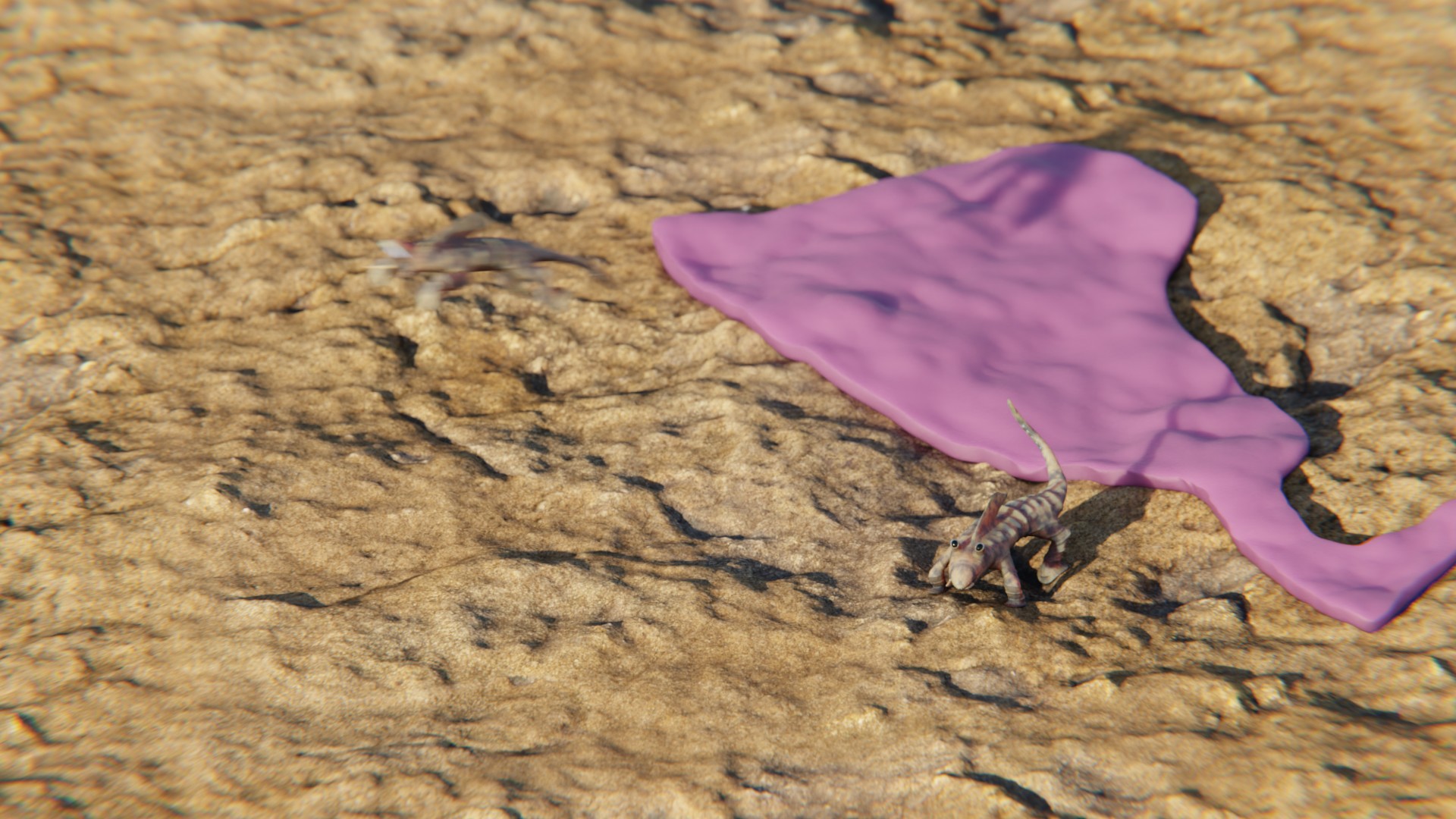Springheel
Yama is a bit of an island continent, and while there is overlap in its fauna with Kub Shay, there are also some unique organisms. One is the springheel. The springheel is an ambush predator adapted to life on land. It is quite small, but also quite fierce. They hunt their prey using their cryptic earth toned coloration, and will leap with surprising force and speed towards their prey. Killing them with their barbed tusks and toothed proboscis. Pictured here one springheel has jumped after some out of frame prey, while another prepares for a similar leap. [Creature design by Dapper Dino]
Basic Information
Anatomy
Springheels have a very similar anatomy to longacrura, maintaining its proboscus, it's tusk like feelers, dorsal projection, all four limbs, eye stalks and tail. The proboscis now sports some hard teeth, used to hold prey that is being eaten, allowing the tusk like feelers to act like a 2 part lower jaw. To facilitate this use of the tusks, they have developed dorsal spikes that are curved posteriorly, making them similar in some ways to theropod teeth in shape and function.
The legs have gained jointing using a hydrostatic system to keep the segments ridged. Interestingly to human eyes these legs seem backwards, with their bending being opposite to that seen in earth tetrapods. The back legs are bigger and closer to centerline, they are use to propell the organism forward into the air. The front legs are widely spaced and smaller and are used to cushion the landing of the springheel.
The tail has a similar look to that of the only distantly related gill chords. This similarity is convergent and the internal anatomy of the tail differs significantly. Each side has 11 spiracles which lead to a central tube that itself leads to a posterior lung sack. This sack is kept moist internally, and the springheel does not need to soak its tail in water like most terrestrial gillchords of its time, however it must drink water frequently to stay hydrated. This lung is surrounded by muscles that will compress it, but the breathing is also aided by limb movement. In fact, a resting springheel not on the hunt will bob up and down to help its lung be more efficient.
The dorsal fin now plays no role in respiration, but it retains a lot of blood vessels, and is used for display, thermoregulation, and also to aid in stability when leaping through the air.
Genetics and Reproduction
Springheels are sexually reproducing diploid organisms that use internal fertilization. The mating individuals will face away from each other with their cloacas touching, at which point the male will transfer a packet of sperm contained in a membrane, that the female will then use to fertilize her eggs. Mating happens around autumn. A single female may mate 3-4 times during a single mating season.
Growth Rate & Stages
Eggs are held internally in batches of about a dozen they will develop internally for approximately 6 days. When they hatch the mother will put them into a pool of fresh water, where they will grow for about 45 days, feeding on small organisms both heterotrophic and autotrophic, until they are large enough and mature enough to come onto land.
Ecology and Habitats
Springheels are adaptable and live in a variety of habitats all around Yama, but require access to fresh water, and so are not found in arid environments.
Dietary Needs and Habits
Springheels mostly eat other xenometazoans, they also will take in small amounts of food in the form of retinalphytes. This provides them with important micronutrients, such as the minerals they need for their hard parts, as well as some additional simple sugars.
Additional Information
Perception and Sensory Capabilities
The eyes on stalks are excellently tuned for detecting motion, but do not have a particularly great angular resolution, and springheels are dichromats. In terms of chemoreception, the feelers are now useless, and the proboscis has taken over that function, now functioning as a taste organ. As a result the springheels have only a week ability to sense chemicals in the water or air, which is not too much of a problem as they are primarily visual diurnal hunters.
EXTINCT
Genetic Ancestor(s)
Scientific Name
Saltamus indominus
Origin/Ancestry
Pseudotetrapoda
Lifespan
4 local years
Average Length
3 cm
Body Tint, Colouring and Marking
Springheels are all cryptically colored, but their exact coloration varries regionally. Those in rocky terrain often favor earth tones, while those that live in humid wetlands tend to go for hues of purples that match the local retinalphytes. The patterns also varry depending on location. It is important for springheels to have good camouflaged as they are ambush hunters.
Geographic Distribution
Remove these ads. Join the Worldbuilders Guild











Comments